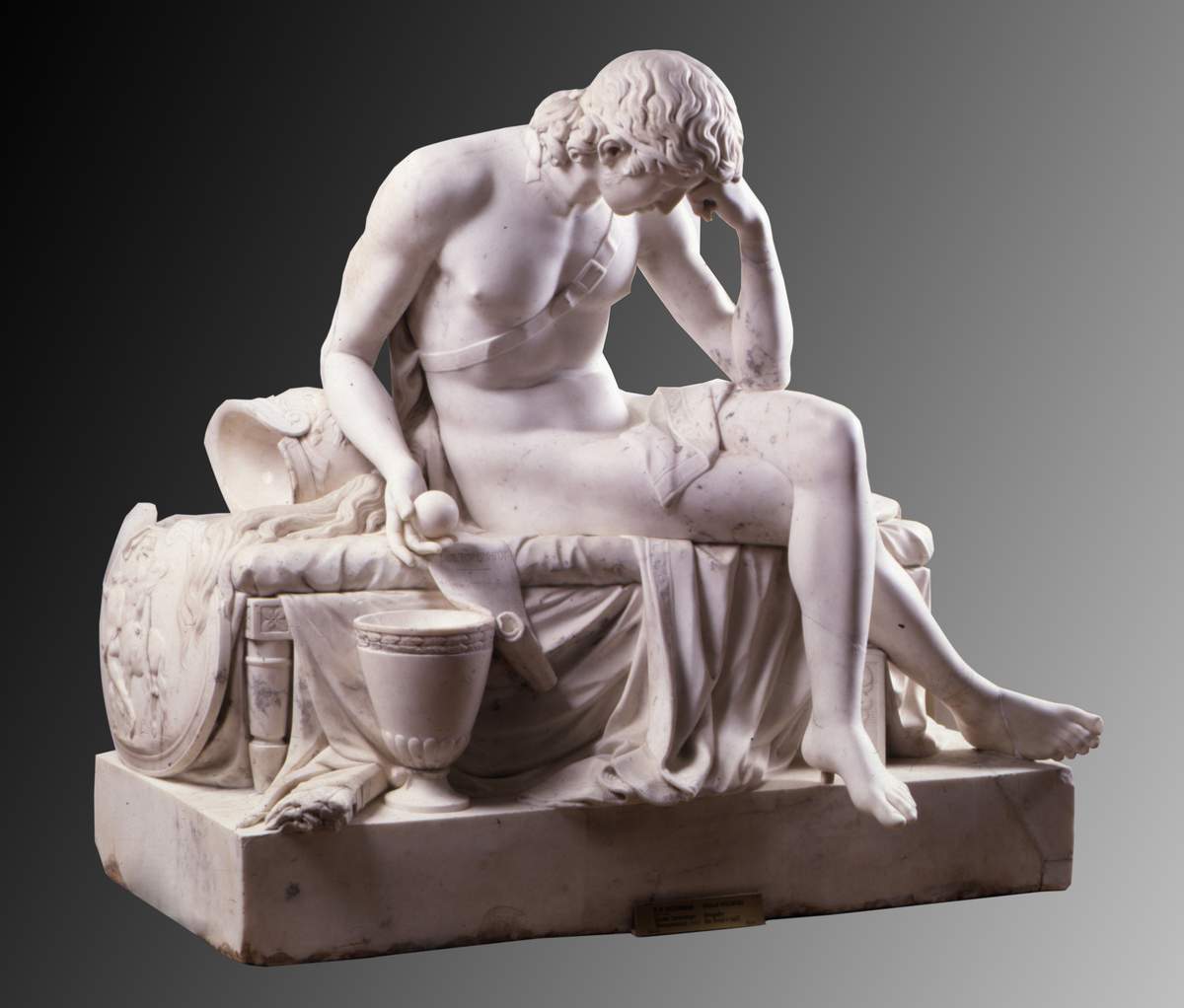


Образ античного героя послужил скульптору для воплощения нравственных идеалов, выработанных просветительской мыслью ХVIII века: Козловский изобразил воспитание твердой воли Александра, которой он противится сну. Одновременно ваятель прославил любовь своего героя к просвещению: около него свиток "Илиады" — свидетельство вкуса и образованности. Оригинальный сюжетный мотив, избранный скульптором, вполне соответствовал морализирующим тенденциям, которые развивались в его творчестве 1780-х годов. Создавая статую, Козловский показывает мощную фигуру отдыхающего воина, исполненную жизненной силы. Ее величавый покой пронизан внутренней готовностью к стремительному движению. Это произведение очень характерно для художественного мышления Козловского, которого современники сравнивали с великим Микеланджело.
В скульптуре ощущается композиционная уравновешенность объемов, ритмическая завершенность и продуманность каждой линии. В целом скульптура рассчитана на фронтальную точку зрения, характеризует постепенное утверждение в русской скульптуре эстетической системы классицизма. Даже декоративные эффекты в расположении атрибутов и драпировок не затмевают того ощущения строгости и сдержанности пластического чувства, которое отличает мраморную фигуру Александра Македонского.
Александр Македонский (356—323 гг. до н.э.) — царь Македонии (с 336 г. до н.э.), выдающийся полководец. Родился в семье македонского царя Филиппа II, воспитывался в спартанском духе, его образованием занимался древнегреческий философ Аристотель. С 16 лет вступил на военную стезю. После смерти отца возглавил эллинистическую армию греческих государств в борьбе против варваров. В результате сокрушительных побед захватил Персию, многие города Средиземноморья и Египта. Создал огромную империю, которая распалась после кончины 33-летнего полководца.
Скульптор, рисовальщик.
Учился в Императорской Академии художеств (1764–1773) у Н. -Ф. Жиле. Неоднократно награждался серебряными и золотыми медалями, получив по окончании обучения звание классного художника 1-й степени и право на заграничное пенсионерство. Совершенствовался в Италии и Франции. Назначенный (1780) за пенсионерскую работу «Юпитер с Ганимедом» (не сохранилась). Принимал участие в декоративном убранстве Мраморного дворца и Концертного зала в Царском Селе (начало 1780-х), создал мраморные статуи «Бдение Александра Македонского» и «Екатерина II в образе Минервы» (обе – Русский музей). Находился в Париже (1788–1790), где исполнил ряд значительных произведений. Академик, профессор (1794). Член Совета Академии художеств (1795). Начал преподавать в скульптурном классе (с 1799 – старший профессор), в числе его учеников были скульпторы В. И. Демут-Малиновский и С. С. Пименов. Работая в области станковой пластики, исполнил ряд портретов и серию терракотовых эскизов на сюжет «Илиады» Гомера (середина 1790-х, Русский музей). Среди его монументальных произведений наиболее значительны – памятник А. В. Суворову для Петербурга (1799–1801), группа «Самсон, раздирающий пасть льва» для Большого каскада в Петергофе (1800–1801), надгробие П. И. Мелиссино (1800) и С. А. Строгановой (1802, оба – в Александро-Невской лавре).

The sculptor took the image of the ancient hero as the embodiment of moral ideals which were worked out by the thought of the Enlightenment of the 18th century: Kozlovsky depicted the education of Alexander's firm will, which helps him to resist sleep. At the same time, the sculptor glorified the love of this hero for enlightenment: the scroll of the Iliad near him is an evidence of taste and education. The original plot motif, chosen by the sculptor, fully corresponded to the moralizing tendencies that were developing in his work during the 1780s. Creating a statue, Kozlovsky shows a powerful figure of a resting warrior, full of vitality. Its majestic peace is imbued with an inner readiness for rapid movement. This work is a very distinct example of the artistic thinking of Kozlovsky, whom his contemporaries compared with the great Michelangelo.
The compositional balance of the volumes, rhythmic completeness and thoughtfulness of each line is felt in the sculpture. In general, the sculpture was designed for a frontal viewpoint, which characterizes the gradual adoption of the aesthetic system of classicism in the Russian sculpture. Even decorative effects in the arrangement of attributes and draperies do not overshadow that sense of severity and restraint of the plastic feeling that distinguishes the marble figure of Alexander the Great.
Alexander of Macedon (356-323 BC) – a king of Macedonia (from 336 BC), an outstanding commander. Born in the family of the Macedonian king Philip II, he was brought up in the Spartan spirit, and the ancient Greek philosopher Aristotle was engaged in his education. At the age of 16 the boy joined the military. After the death of his father, he led the Hellenistic army of the Greek states against the barbarians. As a result of crushing victories he captured Persia and many cities in the Mediterranean and Egypt. He created a huge empire, which disintegrated after the death of the 33-year-old commander.
Sculptor, draughtsman. Studied in Imperial Academy of Arts (1764–1773) under Nicolas-François Gillet. Received multiple silver and gold medals, graduated as class painter of the first grade and right to a foreign funded trip. Mastered in Italy and France. In 1780 became appointed for work “Jupiter with Ganymede” (lost). Participated in decoration of the Marble Palace and Concert Hall in Tsarskoye Selo (beginning of 1780s), created marble statues “The Vigil of Alexander the Great” and “Catherine the Great as Minerva” (both belong now to the Russian Museum). In 1788–1790 stayed in Paris, where created a number of significant works. Academician, professor (1794). Member of Board of Academy of Arts (1795). Started professing in class of sculpture (since 1799 – senior professor); among his students were sculptors Vasily Demut-Malinovsky and Stepan Pimenov. While working in the field of indoor plastics, he created a number of portraits and a set of terracotta sketches on the plot of Homer’s “Iliad” (middle of 1790s, now exhibited in the Russian Museum). Among his most distinguished works are the monument to Alexander Suvorov in Saint Petersburg (1799–1801), group “Samson Slaying the Lion” for the Grand Cascade in Peterhof (1800–1801), grave stone of Pyotr Melissino (1800) and Sofya Stroganova (1802, both located in Alexander Nevsky Monastery).



